22.7: The Mughal Period
- Page ID
- 53080
Architecture of the Mughal Period
Mughal architecture is an Indo-Islamic architectural style that developed in India under the patronage of the Mughal Empire.
Learning Objectives
Differentiate between the architectural accomplishments under the reigns of Akbar, Jahangir, Shah Jahan, and Aurangzeb
Key Takeaways
Key Points
- Mughal architecture is a remarkably symmetrical and decorative amalgam of Persian, Turkish, and Indian architecture.
- Mughal architecture first developed and flourished during the reign of Akbar the Great (1556–1605), where it was known for its extensive use of red sandstone as a building material.
- Humayun’s Tomb, the sandstone mausoleum of Akbar’s father, was built during this period of Mughal architecture.
- Architecture reached its peak in refinement and attention to detail under Shah Jahan (1628–1658), who commissioned the famous Taj Mahal , a white marble mausoleum dedicated to his wife Mumtaz Mahal.
- Mughal architecture began to decline after the death of the emperor Aurangzeb in 1707.
Key Terms
- finial: Any decorative fitting at the peak of a gable or on the top of a flagpole, fence post, or staircase newel post.
- pietra dura: Hard and fine stones in general, as used for inlay and distinguished from the softer stones used in building.
- mausoleum: A large stately tomb or a building housing such a tomb or several tombs.
- lattice: A flat panel constructed with widely spaced crossed thin strips of wood or other material, commonly used as a garden trellis.
Overview: Mughal Architecture
Mughal architecture is the distinctive Indo-Islamic architectural style that developed in northern and central India under the patronage of Mughal emperors from the 16th to the 18th century. It is a remarkably symmetrical and decorative amalgam of Persian, Turkish, and Indian architecture. The Mughals were also renowned for creating exquisite gardens in the Persian charbagh layout, in which the quadrilateral gardens were divided by walkways or flowing water into four smaller parts.
Architecture Under Akbar
Early Mughal architecture first developed during the reign of Akbar the Great (1556–1605), who commissioned palaces, mosques , gardens, and mausoleums. The architecture was a synthesis of Persian, Turkic, Timurid Iranian, Central Asian, and Indian Hindu and Muslim styles. Akbari architecture is also remarkable for its large scale use of sandstone, evident both in the construction of Fatehpur Sikri, Akbar’s royal city, and Akbar’s own tomb in Sikandra. The mosque at Fatehpur Sikri boasts the Buland Darwaza, the largest gateway of its kind in India. Early Mughal mosques had massive enclosed courtyards and domed shallow prayer halls.
Tomb of Humayun
One of the most stellar accomplishments of Mughal architecture under Akbar is the tomb of his father Humayun, situated in Delhi. Commissioned in 1562 by Humayun’s wife, Hamida Banu Begum, and designed by a Persian architect, Humayun’s Tomb was the first garden tomb on the Indian subcontinent and the first structure to use red sandstone on such a large scale. It is also the first Indian building to use the Persian double dome , with an outer layer supporting a white marble exterior—a material not seen in earlier Mughal architecture—and the inner layer giving shape to the cavernous interior volume . The use of indigenous Rajasthani decorative elements is particularly striking, including the small canopies or chhatris (elevated, dome shaped pavilions) surrounding the central dome. It boasts the use of the pietra dura technique, with marble and even stone inlay ornamentation in geometrical and arabesque patterns on the facade of the mausoleum, and jali or latticed stone carving decoration. This style of decorative facade was an important addition to Mughal architecture and flourished in later Mughal mausolea, including the Taj Mahal.
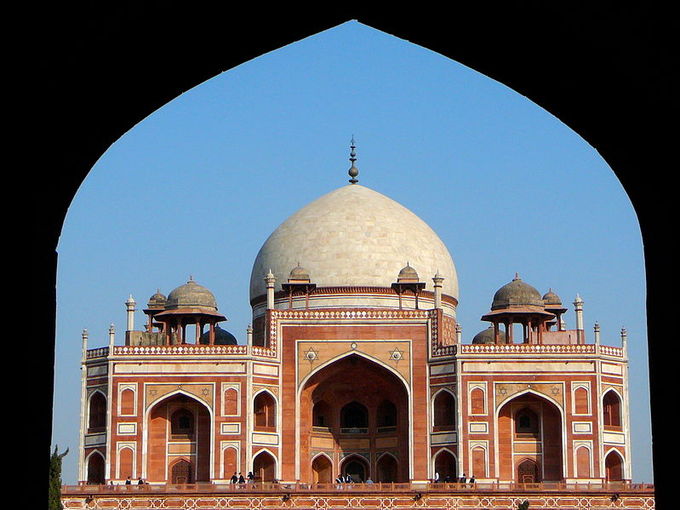
Humayun’s Tomb: Humayun’s Tomb, seen from the main gateway.
Architecture Under Jahangir
Under the rule of Jahangir (1605—1627), Mughal architecture became more Persian than Indian. Jahangir’s great mosque at Lahore is a good example of the Persian style and is covered with enameled tiles. At Agra, the tomb of Itmad-ud-Daula, completed in 1628, was built entirely of white marble and decorated in elaborate pietra dura mosaic , an inlay technique of using cut and fitted, highly polished colored stones to create images.
Architecture Under Shah Jahan
The vision of Shah Jahan (1628—1658) introduced a delicate elegance and detail to Mughal architecture, illustrated in the Jama Masjid in Delhi, the Moti Masjid situated within the Agra Fort, and the Sheesh Mahal in the Lahore Fort, which makes spectacular use of pietra dura and complex mirror work. Shah Jahan’s most famous achievement, however, is indisputably the Taj Mahal.
The Taj Mahal
Located in Agra, the Taj Mahal is a white marble mausoleum built between 1632 and 1648 by Shah Jahan in memory of his third wife, Mumtaz Mahal. Constructed by 20,000 men, it represents the Islamic garden of paradise and is widely regarded as the greatest achievement in Mughal architecture.
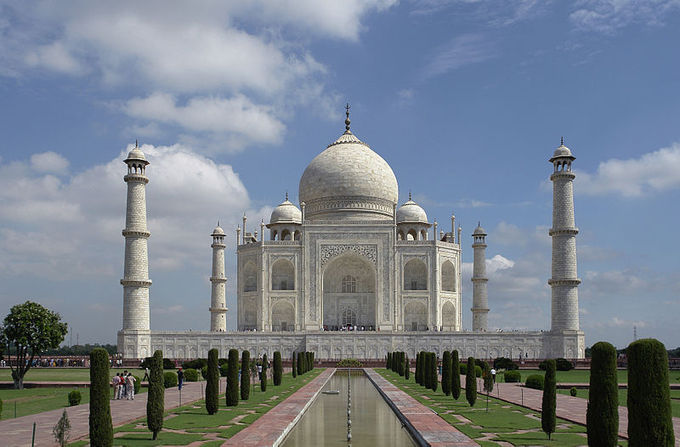
The Taj Mahal: The Taj Majal, built under Shah Jahan, represents the Islamic garden of paradise and is widely regarded as the greatest achievement in Mughal architecture.
The mausoleum rests in the middle of a large square plinth and has four almost identical facades, each with a large arch-shaped doorway. It is topped by a large double dome and a finial , combining both the traditional Islamic motif of the crescent moon and the Hindu symbol of the trident, associated with the god Shiva. The central dome is adorned with a lotus design and is surrounded by four smaller chhatris, each of which also has the same lotus motif. Four tall minarets extend from the corners of the plinth.
The exterior decorations of the Taj Mahal include calligraphy , abstract forms , verses from the Koran, and vegetable motifs, executed in paint, stucco , carvings, and pietra dura work. The interior decorations also feature inlay work of precious and semi-precious gemstones. Muslim tradition forbids elaborate decoration of graves, and the bodies of Shah Jahan and Mumtaz Mahal are interred in a plain crypt underneath the mausoleum. However, the inner tomb features two cenotaphs, or false tombs, that are richly decorated with inlays of semi-precious stones forming vines and flowers and surrounded by jali screens, or latticed screens with ornamental patterns constructed through the use of calligraphy and geometry.
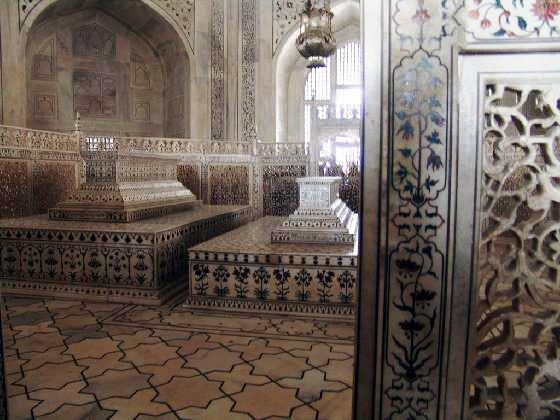
Inside the inner tomb: This is an example of pietra dura inlay work and lattice carvings from the interior of the Taj Mahal.
Aurangzeb and Later Mughal Architecture
During Aurangzeb’s reign (1658–1707), brick and rubble with stucco ornamentation replaced squared stone and marble as the building materials of choice. Aurangzeb was responsible for additions to the Lahore Fort: building one of the 13 gates, which was named for him, and building the Badshahi mosque, a structure constructed from brick with red sandstone facades. In general, however, Mughal architecture had begun to decline during Aurangzeb’s reign, a process that would accelerate after his death.
Painting of the Mughal Period
Mughal miniature painting was a blend of Persian and Indian styles that developed in Mughal courts between the 16th and 19th centuries.
Learning Objectives
Compare and contrast the Akbar, Jahangir, Shah Jahan, and Aurangzeb periods of Mughal painting
Key Takeaways
Key Points
- Mughal painting emerged from the Persian miniature painting tradition, with additional Hindu, Buddhist, and Jain influences; it usually took the form of book illustrations or single sheets preserved in albums.
- There are four periods commonly associated with Mughal art, each named for the emperor under whom the art form developed: the Akbar Period, the Jahangir Period, the Shah Jahan Period, and the Aurangzeb and Later Mughal Period.
- The emperor Akbar set up a large atelier with artists from all parts of his empire. The atelier was responsible for illustrating books on a variety of subjects and developed the methods and techniques used by subsequent Mughal painters.
- The emperor Jahangir was influenced by European art and encouraged his atelier to emulate the single point perspective favored by European painters, unlike the flattened, multi-layered style traditionally used in miniature painting.
- While the artistic focus of the Mughal court shifted primarily to architecture under Shah Jahan, painting continued to flourish; the style became notably more rigid, and the colors used became jewel-like in their brilliance. The emperor Aurangzeb (1658–1707) did not encourage Mughal painting, and only a few portraits survive from his court. Mughal painting essentially came to an end during the reign of Shah Alam II (1759–1806).
Key Terms
- miniature: A small, highly detailed painting or portrait.
- atelier: A workshop or studio meant for an artist, designer, or fashion house.
Overview: Mughal Painting
Mughal painting is a style of South Asian miniature painting that developed in the courts of the Mughal Emperors between the 16th and 19th centuries. It emerged from the Persian miniature painting tradition with additional Hindu, Buddhist, and Jain influences. Mughal painting usually took the form of book illustrations or single sheets preserved in albums. There are four periods commonly associate with Mughal art, each named for the emperor under whom the art form developed: the Akbar Period, the Jahangir Period, the Shah Jahan Period, and the Aurangzeb Period.
Origins
Mughal painting was an amalgam of Ilkhanate Persian and Indian techniques and ideas. Under the Delhi Sultanate, the early 16th century had been a period of artistic inventiveness during which a previously formal and abstract style had begun to make way for a more vigorous and human mode of expression. After Mughal victory over the Delhi Sultanate in 1526, the tradition of miniature painting in India further abandoned the high abstraction of the Persian style and began to adopt a more realistic style of portraiture and of drawing plants and animals.
The Akbar Period (1556–1605)
It was under the reign of Akbar the Great (1556–1605) that Mughal painting came into its own. Trained in painting in his youth by the Persian master ‘Abd al-Samad, Akbar was responsible for setting up the first atelier of court painters, which he staffed with artists from all parts of India whose work he took a keen interest in. This atelier was chiefly responsible for illustrating books on a variety of subjects: histories, romances, poetry, legends, and fables of both Persian and Indian origin.
One of the greatest achievements of Mughal painting under Akbar may be found in the stupendously illustrated Hamzanama or Dastan-e-Amir Hamza, a narration of the legendary exploits of Amir Hamza, the uncle of Muhammad . The size of this manuscript was unprecedented: spanning 14 volumes , it originally contained 1400 illustrations of an unusually large size (approx. 25″ x 16″). Only about 200 of these original illustrations survive today. It took 14 years (1562–1577) and over a hundred men to complete. The paintings mark a significant departure from the Persian style in their bent towards naturalism , vigorous portrayal of movement and emotion, and bold color. Each form is individually modeled, and the figures are interrelated in closely unified compositions . Depth is indicated by a preference for diagonals.
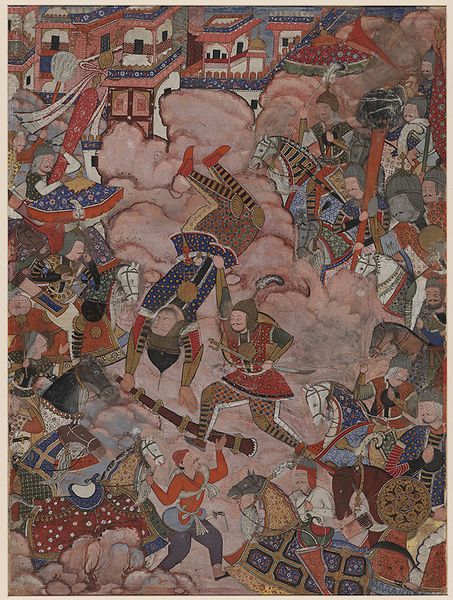
The Battle of Mazandaran: This painting is number 38 in the 7th volume of the Hamzanama. It depicts a battle scene in which the protagonists, Khwajah ‘Umar and Hamzah, and their armies engage in fierce battle. Originally clearly depicted, the faces were erased by iconoclasts and then repainted in more recent times. Only the face of the groom wearing an orange turban in the center of the left edge has been left untouched.
Methods and Techniques Under Akbar
The methods most commonly used by Mughal painters were first developed in Akbar’s great atelier. Illustrations were usually executed by groups of painters, including a colorist (who was responsible for the actual painting) and specialists in portraiture and the mixing of colors. Leading this group was the designer, an artist of the highest caliber, who formulated the composition and sketched the outline into the spaces in the manuscripts designated by the calligraphers for illustration. A thin wash of white was then applied, through which the outline remained visible. The colors were then applied in several thin layers and rubbed down with an agate burnisher to produce a glowing, enamel-like finish. The colors used were mostly mineral and sometimes vegetable dyes, and the fine brushes were made from squirrel’s tail or camel hair.
The Jahangir Period (1605–1627)
Like his father Akbar, the emperor Jahangir showed a keen interest in painting and maintained his own atelier. The tradition of illustrating books assumed secondary importance to portraiture during Jahangir’s reign because of the emperor’s own preference for portraits. Among the finest works of his reign are elaborate court scenes depicting him surrounded by his courtiers. These are large scale exercises in portraiture, and the likeness of each figure is produced faithfully. The composition lacks the vigor, movement, and vivid color characterized by the works of Akbar’s reign; the figures are more formally ordered, the colors soft and harmonious, and the brushwork particularly fine. Mughal paintings during Jahangir’s reign also boast magnificent floral and geometric borders.
European Influence
Jahangir was also deeply influenced by European painting, having come into contact with the English crown and received gifts of oil paintings from England. He encouraged his atelier to emulate the single point perspective favored by European painters, unlike the flattened, multi-layered style traditionally used in miniature painting. These influences are evident in the illustrations of the Jahangirnama, a biographical account of Jahangir’s own life. In addition to portraits, many works included plant and animal studies and became part of lavishly finished albums. Most illuminated manuscripts were created by a single painter.
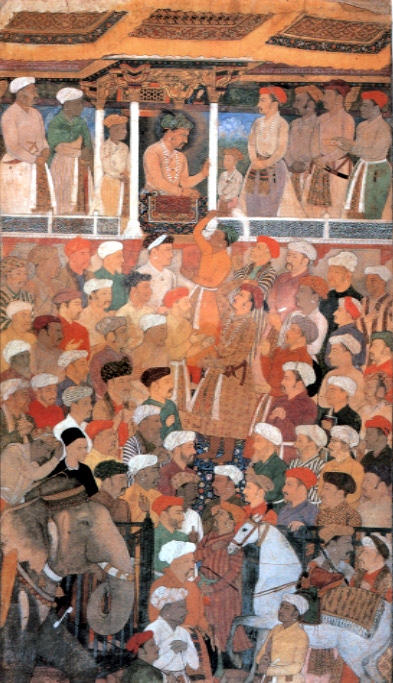
Jahangir in Darbar: Illustration of a court scene from the Jahangirnama, c. 1620. Jahangir makes a public appearance on a balcony as a large group of courtiers stand below.
The Shah Jahan Period (1628–1658)
While the artistic focus of the Mughal court shifted primarily to architecture under Shah Jahan, painting continued to flourish. The style became notably more rigid, and portraits resembled abstract effigies . Paintings of this period were particularly opulent, as the colors used became jewel-like in their brilliance. Popular themes included musical parties, lovers in terraces and gardens—sometimes locked in intimate embraces—and ascetics and holy men.
The Aurangzeb and Late Mughal Period (1658–1809)
The emperor Aurangzeb (1658–1707) did not encourage Mughal painting, and only a few portraits survive from his court. Most of these were accomplished in the cold, abstract style of Shah Jahan. While the art form had gathered sufficient momentum to invite patronage in other courts—Muslim, Hindu, and Sikh alike—the absence of strong imperial backing ushered in a decline of the art form. A brief revival occurred during the reign of Muhammad Shah (1719–1748), who was passionately devoted to the arts, but this was only temporary. Mughal painting essentially came to an end during the reign of Shah Alam II (1759–1806), and the artists of his disintegrated court contented themselves with copying masterpieces of the past.
Rajput Painting of the Mughal Period
Rajput miniature painting developed in the courts of the Hindu Rajputs between the 16th and 19th centuries.
Learning Objectives
Describe the different techniques and schools associated with both the Rajasthani and the Pahari styles of Rajput painting
Key Takeaways
Key Points
- Rajput painting flowed primarily from the indigenous Western Indian style of manuscript illustration that had flourished in the 14th and 15th centuries, but was also greatly influenced by Mughal painting.
- Rajput painting usually took the form of miniatures in manuscripts or on single sheets kept in albums, although examples of this style can also be found on the walls of Rajput palaces, forts, and mansions.
- Popular themes include the life of the god Krishna; scenes from Hindu epics; pictorial representations of the ragamala (musical modes); women, lovers and romance; portraits; and court and hunting scenes.
- Rajput painting can be divided into two styles: the Rajasthani style, associated with the Rajput courts in Rajasthan, and the Pahari style, associated with the Rajput courts of the Himalayan foothills.
Key Terms
- Stylized: Represented according to some convention, rather than in a realistic or literal manner.
- lyricism: Depth of feeling and imagination.
Overview: The Hindu Rajput Kingdoms
The Rajputs are members of patrilineal clans in western, central, and northern India who rose to prominence between the 6th and 12th centuries. From the beginning of the 9th century, these Rajput dynasties dominated many parts of northern India, and they established the overwhelming majority of Hindu princely states in Rajasthan and Surashtra in northwestern India, which they ruled until the 20th century. Some important dynasties include the Chauhan Dynasty of Ajmer and Delhi (956–1192); the Solanki Dynasty of present day Gujarat (945–1297); and the Chandela Dynasty of the Bundelkhand Region of central India (10th to 13th centuries). During the period of Islamic invasions (11th through 16th centuries), the Rajput kingdoms proved to be the primary obstacle to the complete Muslim conquest of Hindu India.
Rajput and Mughal Relations
Under the Mughal emperor Akbar’s reign (1556–1605 CE), the Rajputs accepted Mughal authority in exchange for religious accommodation and were admitted into the emperor’s court. Many Rajputs assumed positions in Akbar’s government and army or formed marital alliances with him. Mughal-Rajput relations suffered, however, under the reign of the Mughal emperor Aurangzeb (1658–1707), who did not pursue the policy of religious accommodation of his predecessors.
Through their many centuries of rule in northern India, the Rajputs built spectacular temples, forts, and palaces and were eager patrons of painting. Rajput and Mughal art and architecture were also important influences on one another once the two powers came into contact.
Rajput Painting
Rajput painting is the style of Indian miniature painting associated with the royal courts of the Rajputs between the 16th and the 19th centuries. It flowed primarily from the indigenous Western Indian style of manuscript illustration that had flourished in the 14th and 15th centuries, but it was also greatly influenced by Mughal painting. Rajput painting usually took the form of miniatures in manuscripts or on single sheets kept in albums, although examples of this style can also be found on the walls of Rajput palaces, forts, or havelis (mansions). Early Rajput painting was almost exclusively devoted to the life and deeds of Krishna, the Hindu cowherd god. Other popular themes included scenes from Hindu epics, the Ramayana and the Mahabharata; pictorial representations of the ragamala (musical modes); women, lovers, and romance; portraits; and court and hunting scenes.
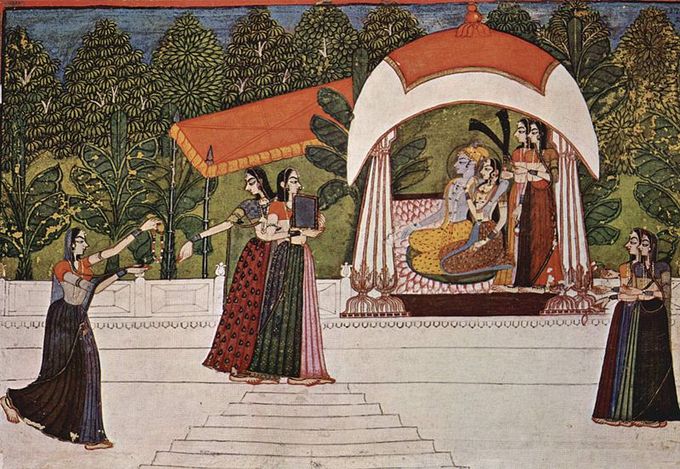
Krishna and Radha in a Pavilion: An 18th century Rajput painting by the artist Nihâl Chand, chief painter at the court of Kishangarh. Krishna and his companions are by far the most popular theme of Rajput painting.
The colors used in Rajput painting were extracted from minerals, plant sources, conch shells, beetle wings, and sometimes even precious stones. Gold and silver were also used. The preparation of these colors was a lengthy process that could take weeks to accomplish. The brushes used were very fine, in keeping with the requirements of fine miniature painting.
Styles of Painting
Rajput painting can be divided into two styles: the Rajasthani style, associated with the Rajput courts in Rajasthan, and the Pahari style, associated with the Rajput courts of the Himalayan foothills.
The Rajasthani Style
Emerging in the last decades of the 16th century, Rajasthani art is usually divided into four major schools, each centered on different courts and based on differences in artistic style. These four schools are the Mewar school, the Marwar school, the Hadoti school, and the Dhundar school.
- The Mewar school is associated with the courts of Chavand, Nathwara, Devgarh, Udaipur, and Sawar and is characterized by simplicity and vivid colors. It produced a large number of devotional paintings for the pilgrim trade.
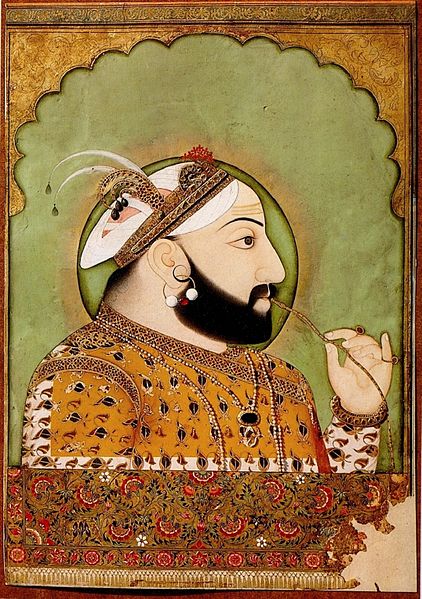
Maharana Sangram Singh II of Mewar: Udaipur, Mewar, 1725–35. Opaque watercolor on paper, set with pearls and precious stones. This is a good example of portraiture in the Rajput style and of the Mewar School’s work.
- The Marwar school is associated with the courts of Kishangarh, Bikaner, Jodhpur, Nagaur, Pali, and Ghanerao courts. It is best known for its fine miniature portraits from the second half of the 17th century and a large body of highly stylized and colorful painting from the 19th century.
- The Hadoti school is associated with the courts of Kota, Bundi, and Jhalawar and is remarkable for its vivid portrayal of movement, strength, and vitality , best seen in depictions of hunting and sports scenes.
- The Dhundar school is associated with the courts of Amber, Jaipur, Shekhawati, and Uniara and is characterized by formal yet rich portraits, very large paintings of the deeds of Krishna, and Western influences in the 19th century.
The Pahari Style
The Pahari style of miniature painting and book illustration developed in the independent states of the Himalayan foothills between the 17th and 18th centuries and began to decline after 1800. This style consists of two schools: the Basohli school and the Kangra school.
- The Basohli school flourished toward the end of the 17th century; it is best known for its bold use of color, intense emotionality, stylized facial types shown in profile with prominent eyes, and distinctive depictions of jewelry.
- The Kangra school emerged in the mid-18th century as the Basohli style began to fade and is characterized by curving lines , calmer colors, and delicate lyricism .
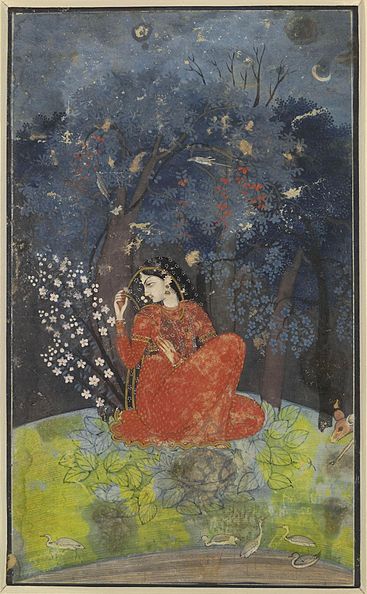
Utka Nayika: A Lady Awaits Her Lover in the Forest: An example of Pahari painting from the Kangra school dated between 1775–1780. The subject matter—lovers and romance—is a popular theme in Rajput painting.
- Curation and Revision. Provided by: Boundless.com. License: CC BY-SA: Attribution-ShareAlike
- Humayun's Tomb from the entrance, Delhi. Provided by: Wikimedia. Located at: commons.wikimedia.org/wiki/File:Humayun's_Tomb_from_the_entrance,_Delhi.jpg. License: CC BY: Attribution
- Taj Mahal, Agra, India edit2. Provided by: Wikimedia. Located at: commons.wikimedia.org/wiki/File:Taj_Mahal,_Agra,_India_edit2.jpg. License: CC BY-SA: Attribution-ShareAlike
- TajCenotaphs3. Provided by: Wikipedia. Located at: en.Wikipedia.org/wiki/File:TajCenotaphs3.jpg. License: Public Domain: No Known Copyright
- Mughal architecture. Provided by: Wikipedia. Located at: en.Wikipedia.org/wiki/Mughal_architecture. License: CC BY-SA: Attribution-ShareAlike
- Taj Mahal. Provided by: Wikipedia. Located at: en.Wikipedia.org/wiki/Taj_Mahal. License: CC BY-SA: Attribution-ShareAlike
- Humayun's Tomb. Provided by: Wikipedia. Located at: en.Wikipedia.org/wiki/Humayun's_Tomb. License: CC BY-SA: Attribution-ShareAlike
- Mughal Gardens. Provided by: Wikipedia. Located at: en.Wikipedia.org/wiki/Mughal_Gardens. License: CC BY-SA: Attribution-ShareAlike
- lattice. Provided by: Wiktionary. Located at: en.wiktionary.org/wiki/lattice. License: CC BY-SA: Attribution-ShareAlike
- mausoleum. Provided by: Wiktionary. Located at: en.wiktionary.org/wiki/mausoleum. License: CC BY-SA: Attribution-ShareAlike
- finial. Provided by: Wiktionary. Located at: en.wiktionary.org/wiki/finial. License: CC BY-SA: Attribution-ShareAlike
- pietra dura. Provided by: Wiktionary. Located at: en.wiktionary.org/wiki/pietra_dura. License: CC BY-SA: Attribution-ShareAlike
- The battle of Mazandaran. Provided by: Wikipedia. Located at: en.Wikipedia.org/wiki/File:The_battle_of_Mazandaran.jpg. License: Public Domain: No Known Copyright
- Jahangir in Darbar, from the Jahangir-nama, c.1620. Provided by: Wikipedia. Located at: en.Wikipedia.org/wiki/File:Jahangir_in_Darbar,_from_the_Jahangir-nama,_c.1620.jpg. License: Public Domain: No Known Copyright
- Visual Arts Of The Indian Subcontinent. Provided by: Wikibooks. Located at: en.wikibooks.org/wiki/Visual_Arts_Of_The_Indian_Subcontinent. License: CC BY-SA: Attribution-ShareAlike
- Mughal painting. Provided by: Wikipedia. Located at: en.Wikipedia.org/wiki/Mughal_painting. License: CC BY-SA: Attribution-ShareAlike
- Hamzanama. Provided by: Wikipedia. Located at: en.Wikipedia.org/wiki/Hamzanama. License: CC BY-SA: Attribution-ShareAlike
- miniature. Provided by: Wiktionary. Located at: en.wiktionary.org/wiki/miniature. License: CC BY-SA: Attribution-ShareAlike
- atelier. Provided by: Wiktionary. Located at: en.wiktionary.org/wiki/atelier. License: CC BY-SA: Attribution-ShareAlike
- Utka Nayika awaits her lover in the forest. Kangra painting, ca.1775-1780.. Provided by: Wikimedia. Located at: upload.wikimedia.org/Wikipedia/commons/thumb/1/10/Utka_Nayika._A_lady_awaits_her_lover_in_the_forest._1775-1780._Kangra,_British_Museum,_London.jpg/367px-Utka_Nayika._A_lady_awaits_her_lover_in_the_forest._1775-1780._Kangra,_British_Museum,_London.jpg. License: Public Domain: No Known Copyright
- Provided by: Wikimedia. Located at: upload.wikimedia.org/Wikipedia/commons/thumb/e/e9/1_Maharana_Sangram_Singh_II_of_Mewar._Udaipur,_Mewar,_1725-35,_Opaque_watercolor_on_paper,_set_with_pearls_and_precious_stones._Collection_Gopi_Krishna_Kanoria,_Patna..jpg/422px-thumbnail.jpg. License: Public Domain: No Known Copyright
- Nihu00e2l Chand. Provided by: Wikipedia. Located at: en.Wikipedia.org/wiki/Nih%C3%A2l_Chand. License: Public Domain: No Known Copyright
- Rajput painting. Provided by: Wikipedia. Located at: en.Wikipedia.org/wiki/Rajput_painting. License: CC BY-SA: Attribution-ShareAlike
- Visual Arts Of The Indian Subcontinent. Provided by: Wikibooks. Located at: en.wikibooks.org/wiki/Visual_Arts_Of_The_Indian_Subcontinent. License: CC BY-SA: Attribution-ShareAlike
- Boundless. Provided by: Boundless Learning. Located at: www.boundless.com//art-history/definition/lyricism. License: CC BY-SA: Attribution-ShareAlike
- Stylized. Provided by: Wiktionary. Located at: en.wiktionary.org/wiki/Stylized. License: CC BY-SA: Attribution-ShareAlike
- Rajput. Provided by: Wikipedia. Located at: en.Wikipedia.org/wiki/Rajput. License: CC BY-SA: Attribution-ShareAlike
- Hindu Rajput Kingdoms. Provided by: Boundless. Located at: www.boundless.com/users/307859/textbooks/painting-1-8adf00aa-c11d-45a0-864a-1de2e11ad1f5/art-of-south-and-southeast-asia-before-1200-south-and-southeast-asia-after-1200-17/india-161/hindu-rajput-kingdoms-642-5427/. License: CC BY-SA: Attribution-ShareAlike

